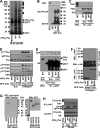Cell adhesion-dependent serine 85 phosphorylation of paxillin modulates focal adhesion formation and haptotactic migration via association with the C-terminal tail domain of talin
- PMID: 22761432
- PMCID: PMC3431675
- DOI: 10.1074/jbc.M111.323360
Cell adhesion-dependent serine 85 phosphorylation of paxillin modulates focal adhesion formation and haptotactic migration via association with the C-terminal tail domain of talin
Abstract
Integrin-mediated adhesion to extracellular matrix proteins is dynamically regulated during morphological changes and cell migration. Upon cell adhesion, protein-protein interactions among molecules at focal adhesions (FAs) play major roles in the regulation of cell morphogenesis and migration. Although tyrosine phosphorylation of paxillin is critically involved in adhesion-mediated signaling, the significance of paxillin phosphorylation at Ser-85 and the mechanism by which it regulates cell migration remain unclear. In this study, we examined how Ser-85 phosphorylation of paxillin affects FA formation and cell migration. We found that paxillin phosphorylation at Ser-85 occurred during HeLa cell adhesion to collagen I and was concomitant with tyrosine phosphorylation of both focal adhesion kinase and talin. However, the non-phosphorylatable S85A mutant of paxillin impaired cell spreading, FA turnover, and migration toward collagen I but not toward serum. Furthermore, whereas the (presumably indirect) interaction between paxillin and the C-terminal tail of talin led to dynamic FAs at the cell boundary, S85A paxillin did not bind talin and caused stabilized FAs in the central region of cells. Together, these observations suggest that cell adhesion-dependent Ser-85 phosphorylation of paxillin is important for its interaction with talin and regulation of dynamic FAs and cell migration.
Figures







Similar articles
-
Leupaxin is similar to paxillin in focal adhesion targeting and tyrosine phosphorylation but has distinct roles in cell adhesion and spreading.Cell Adh Migr. 2010 Oct-Dec;4(4):527-40. doi: 10.4161/cam.4.4.12399. Cell Adh Migr. 2010. PMID: 20543562 Free PMC article.
-
O-GlcNAcylation regulates integrin-mediated cell adhesion and migration via formation of focal adhesion complexes.J Biol Chem. 2019 Mar 1;294(9):3117-3124. doi: 10.1074/jbc.RA118.005923. Epub 2018 Dec 26. J Biol Chem. 2019. PMID: 30587575 Free PMC article.
-
Phosphorylation of phosphatidylinositol 4-phosphate 5-kinase γ by Akt regulates its interaction with talin and focal adhesion dynamics.Biochim Biophys Acta. 2015 Oct;1853(10 Pt A):2432-43. doi: 10.1016/j.bbamcr.2015.07.001. Epub 2015 Jul 4. Biochim Biophys Acta. 2015. PMID: 26149501
-
Paxillin: a crossroad in pathological cell migration.J Hematol Oncol. 2017 Feb 18;10(1):50. doi: 10.1186/s13045-017-0418-y. J Hematol Oncol. 2017. PMID: 28214467 Free PMC article. Review.
-
The explorations of dynamic interactions of paxillin at the focal adhesions.Biochim Biophys Acta Proteins Proteom. 2022 Oct 1;1870(10):140825. doi: 10.1016/j.bbapap.2022.140825. Epub 2022 Aug 1. Biochim Biophys Acta Proteins Proteom. 2022. PMID: 35926716 Review.
Cited by
-
Post-translational modification-regulated leukocyte adhesion and migration.Oncotarget. 2016 Jun 14;7(24):37347-37360. doi: 10.18632/oncotarget.8135. Oncotarget. 2016. PMID: 26993608 Free PMC article. Review.
-
Gold Nanorod Photothermal Therapy Alters Cell Junctions and Actin Network in Inhibiting Cancer Cell Collective Migration.ACS Nano. 2018 Sep 25;12(9):9279-9290. doi: 10.1021/acsnano.8b04128. Epub 2018 Aug 27. ACS Nano. 2018. PMID: 30118603 Free PMC article.
-
Downregulation of Talin-1 expression associates with increased proliferation and migration of vascular smooth muscle cells in aortic dissection.BMC Cardiovasc Disord. 2017 Jun 20;17(1):162. doi: 10.1186/s12872-017-0588-0. BMC Cardiovasc Disord. 2017. PMID: 28637452 Free PMC article.
-
Quantitative phosphoproteomic analysis identifies the potential therapeutic target EphA2 for overcoming sorafenib resistance in hepatocellular carcinoma cells.Exp Mol Med. 2020 Mar;52(3):497-513. doi: 10.1038/s12276-020-0404-2. Epub 2020 Mar 19. Exp Mol Med. 2020. PMID: 32203105 Free PMC article.
-
Cell matrix adhesions in cancer: The proteins that form the glue.Oncotarget. 2017 Jul 18;8(29):48471-48487. doi: 10.18632/oncotarget.17265. Oncotarget. 2017. PMID: 28476046 Free PMC article. Review.
References
-
- Danen E. H. (2009) Integrin proteomes reveal a new guide for cell motility. Sci. Signal. 2, pe58. - PubMed
-
- Mitra S. K., Schlaepfer D. D. (2006) Integrin-regulated FAK-Src signaling in normal and cancer cells. Curr. Opin. Cell Biol. 18, 516–523 - PubMed
-
- Schaller M. D. (2010) Cellular functions of FAK kinases: insight into molecular mechanisms and novel functions. J. Cell Sci. 123, 1007–1013 - PubMed
-
- Lock J. G., Wehrle-Haller B., Stromblad S. (2008) Cell-matrix adhesion complexes: master control machinery of cell migration. Semin. Cancer Biol. 18, 65–76 - PubMed
-
- Carragher N. O., Frame M. C. (2004) Focal adhesion and actin dynamics: a place where kinases and proteases meet to promote invasion. Trends Cell Biol. 14, 241–249 - PubMed
Publication types
MeSH terms
Substances
LinkOut - more resources
Full Text Sources
Research Materials
Miscellaneous

